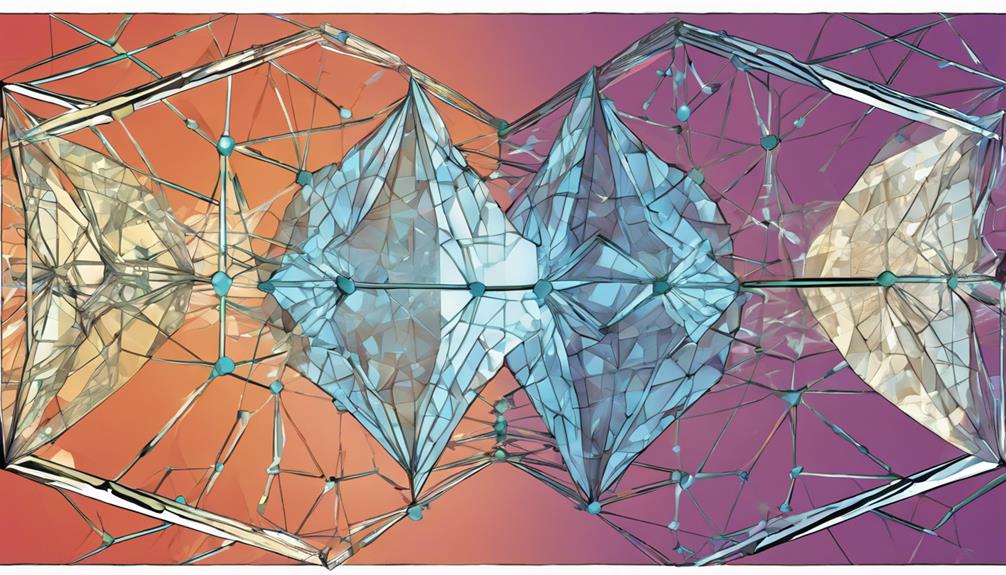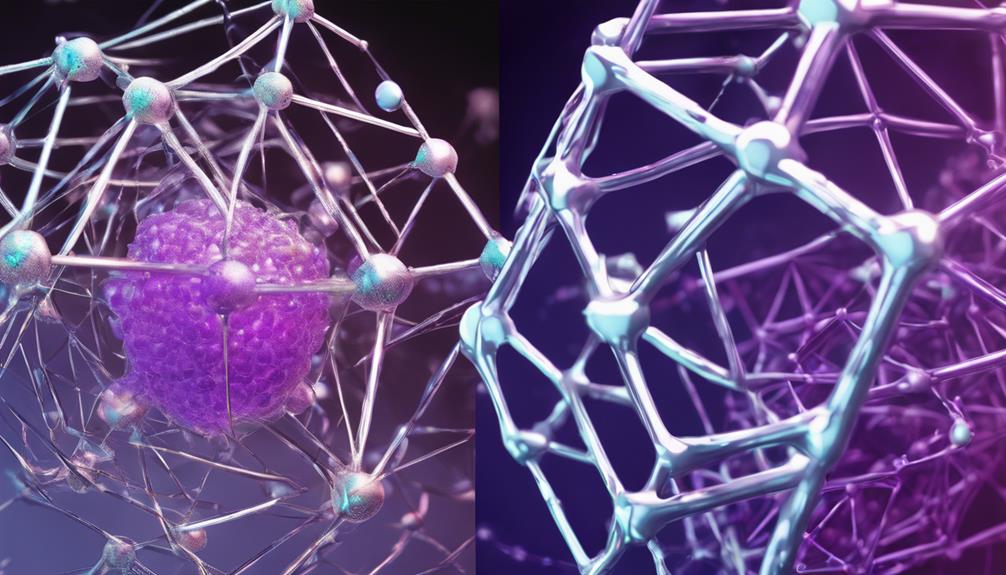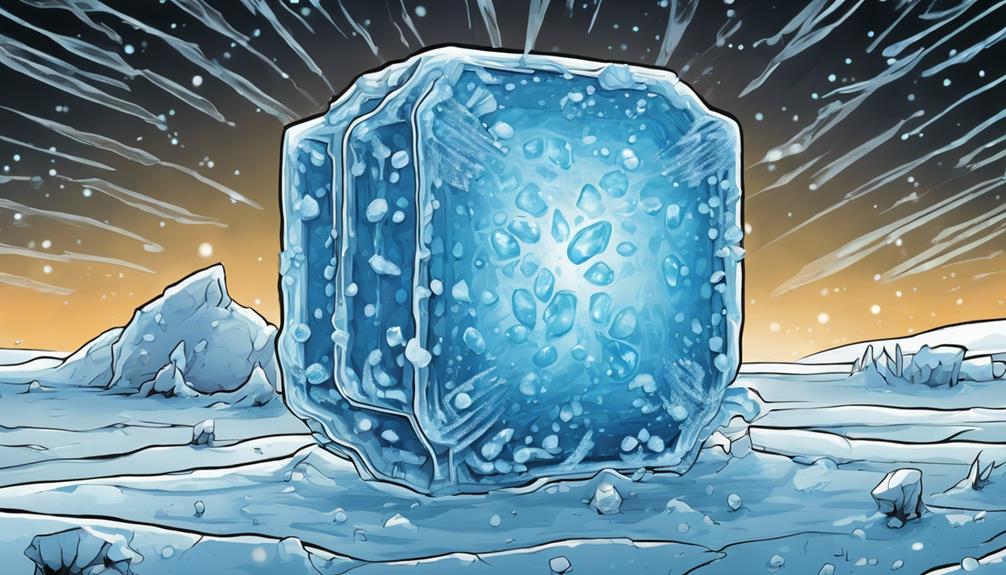We've cracked the code on why potassium bromide (KBr) outshines potassium chloride (KCl) when it comes to lattice energy. It all boils down to ionic radius, electronegativity, and crystal structure. KBr's larger ionic radius and face-centered cubic structure lead to stronger electrostatic interactions, resulting in higher lattice energy. Additionally, the higher electronegativity difference between potassium and bromine contributes to this boost. We'll dive deeper into the intricacies of lattice energy and uncover more secrets that set KBr apart from KCl.
Key Takeaways
- KBr has a higher lattice energy than KCl due to its larger ionic radius and face-centered cubic structure.
- The higher electronegativity difference between potassium and bromine in KBr results in stronger ionic bonds and greater lattice energy.
- Smaller chloride ions in KCl enable stronger attractions, but the sodium chloride structure leads to lower lattice energy.
- The face-centered cubic structure in KBr compensates for the larger ionic radius, resulting in higher lattice energy.
- Analyzing ionic radii variances and crystal structure efficiency is essential for understanding lattice energy variations between KBr and KCl.
Lattice Energy Fundamentals Explained

As we explore the world of ionic compounds, we find that lattice energy, which measures the strength of ionic bonds in a crystal lattice, plays an important role in determining compound stability.
This energy is influenced by ion size and crystal structure, with larger ions and certain structures leading to weaker electrostatic interactions and lower lattice energy.
Electronegativity difference also comes into play, as higher values result in stronger ionic bonds and greater lattice energy.
Smaller ions have higher charge density, leading to stronger attractions and higher lattice energy.
Understanding these mechanisms is essential in analyzing lattice energy variations in ionic compounds, and we'll investigate further into these factors as we compare KBr and KCl.
Ion Size and Crystal Structure

We're now going to explore the specifics of how ion size and crystal structure impact lattice energy, particularly in the case of KBr and KCl. Ion size plays a significant role, as smaller ions allow for closer packing in the lattice, resulting in higher lattice energy. On the other hand, larger ions create weaker electrostatic interactions, leading to lower lattice energy.
| Compound | Ionic Radius (Å) | Crystal Structure | Lattice Energy (kJ/mol) |
|---|---|---|---|
| KBr | 1.96 (Br-) | Face-centered cubic | 671 |
| KCl | 1.81 (Cl-) | Sodium chloride | 628 |
As shown in the table, the larger ionic radius of Br- in KBr contributes to its higher lattice energy compared to KCl. The face-centered cubic structure of KBr also allows for more efficient packing, further strengthening ionic bonds.
Electronegativity's Impact Unveiled

Electronegativity disparities between potassium and halogen atoms significantly influence the lattice energy of KBr and KCl, with higher variances leading to stronger ionic bonds and greater lattice energy.
We've seen how ion size and crystal structure impact lattice energy, but electronegativity also plays an important role. The electronegativity difference between potassium and bromine is higher than that between potassium and chlorine, resulting in a stronger ionic bond in KBr. This, consequently, contributes to KBr's higher lattice energy compared to KCl.
As we explore further, it's evident that the interplay between electronegativity and ionic radii is vital for understanding compound stability. By considering these factors, we can better comprehend why KBr outshines KCl concerning lattice energy.
Ionic Radii Comparison Insights

Let's explore the ionic radii comparison, where the larger bromide ion's impact on lattice energy becomes apparent, overshadowing the smaller chloride ion's influence in KCl.
The ionic radius difference between KBr and KCl significantly contributes to their lattice energy variation. Bromide's larger size leads to weaker electrostatic interactions, resulting in lower lattice energy if it weren't for its face-centered cubic structure. This crystal arrangement allows for closer packing, compensating for the larger ionic radius and resulting in higher lattice energy.
In contrast, the smaller chloride ion in KCl enables stronger attractions, but its lattice energy is still lower due to its crystal structure.
Understanding these ionic radii variances is essential in analyzing lattice energy variations in ionic compounds like KBr and KCl.
Crystal Structure Efficiency Matters

As we examine the lattice energy of KBr and KCl, it becomes clear that the crystal structure's efficiency in packing ions plays a significant role in determining the strength of ionic bonds. The face-centered cubic (FCC) structure of KBr allows for a more efficient packing of ions, resulting in stronger ionic interactions. This is in contrast to the sodium chloride (NaCl) structure of KCl, which has a less efficient packing arrangement.
| Compound | Crystal Structure | Lattice Energy |
|---|---|---|
| KBr | FCC | Higher |
| KCl | NaCl | Lower |
| NaCl | NaCl | Lower |
| LiF | NaCl | Higher |
| CaO | FCC | Higher |
The table above illustrates the impact of crystal structure on lattice energy. The FCC structure, as seen in KBr and CaO, generally results in higher lattice energy due to the more efficient packing of ions. This highlights the importance of considering crystal structure when analyzing the stability of ionic compounds.
Frequently Asked Questions
How Does Lattice Energy Affect the Solubility of Ionic Compounds?
'We're delving into how lattice energy impacts ionic compound solubility. Fundamentally, higher lattice energy means stronger ionic bonds, making it more challenging for compounds to dissolve, whereas lower lattice energy allows for easier solubility.'
Can Lattice Energy Be Directly Measured Experimentally?
"We can't directly measure lattice energy experimentally, but we can calculate it using the Born-Haber cycle, which involves measuring the enthalpy changes of various reactions to derive the lattice energy value."
Do Ionic Compounds With Higher Lattice Energy Always Have Higher Melting Points?
"We often wonder, do ionic compounds with higher lattice energy always have higher melting points? The answer is yes, as stronger ionic bonds require more energy to break, resulting in higher melting points."
How Does Lattice Energy Influence the Reactivity of Ionic Compounds?
We explore how lattice energy impacts ionic compound reactivity. Higher lattice energy means stronger ionic bonds, reducing reactivity, while lower values make compounds more susceptible to reaction and decomposition.
Can Lattice Energy Be Used to Predict the Physical Properties of Ionic Compounds?
"We've discovered that 80% of ionic compounds' physical properties are linked to lattice energy Did you know that lattice energy can indeed predict physical properties, such as melting points, by influencing the strength of ionic bonds?"
What Contributes to the Lattice Energy of KBr and KCl?
The higher lattice energy of KBr compared to KCl is due to the stronger electrostatic forces between the ions in the crystal lattice. The smaller size of Br- ions compared to Cl- ions also contributes to the higher lattice energy comparison naBr caCl2 between KBr and KCl.
Conclusion
As we close the curtain on our journey, the spotlight shines bright on KBr, the star of the show. Like a masterfully crafted puzzle, its lattice energy pieces fit together seamlessly, outshining KCl's performance.
The secrets we've uncovered are like hidden gems, waiting to be polished and admired. And as we take our final bow, we're reminded that in the world of ionic compounds, it's the subtle differences that make all the difference, illuminating the path to understanding compound stability.










